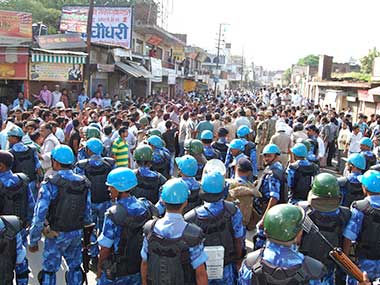In the euphoria following the spectacular victory of the BJP in the parliament elections, even Prime Minister Narendra Modi’s critics were of the opinion that he would be on a strong wicket if he took care of two issues: a healthy economic growth and the absence of major communal riots. [caption id=“attachment_1688839” align=“alignleft” width=“380”]  File photo of security personnel during the Muzaffarngar riots. AP[/caption] But Modi’s ascendance to power was preceded by the Muzaffarnagar riots, the worst in Uttar Pradesh since the post-Ayodhya mayhem in 1992. About 60 people died and 100,000 were rendered homeless, or rather displaced, in their own land. Major riots also broke out in Saharanpur, Meerut and Moradabad. Today, the embers of Muzaffarnagar and other places are sources of huge worry. Not only things are not looking better, but they are also getting worse because there’s hardly any reparation - social, political and psychological Media reports indicate that the displaced Muslims in Muzaffarnagar are too scared to return and are engaged in distress sale of their properties. They don’t feel safe on the land they were born and raised, and are willing to sell away their homes for dirt cheap prices. The details of the distress sale, as reported by Financial Express are extremely disturbing. It quotes village pradhan Ravinder Singh who said that in the past six weeks, 150 of the 250 Muslim families have sold their homes to Jat neighbours. “The situation is such that small incidents are taking communal colours — accidents, robberies, you name it. It has been like this for a year, in an area which never knew communal tension. So no matter what we say, the Muslims want to leave our village, and the Jats are not trying too hard to stop them either,” Singh said. Every day “more Muslims are coming to me with requests to sell their property,” he is quoted as saying in the report. If this is unchecked, what would effectively happen will be a demographic change in the riot hit areas. In fact, the displacement of 100,000 people has already resulted in a demographic makeover. Who knows, probably those who engineered the riots had this design in mind; or probably, this is the routine spin-off of a communal riot. This is not a good sign for the national government because radical voices vitiate the atmosphere on the ground and without active intervention, this too will be called, rightly or wrongly, a “lab of Hindutva”. For Modi, who appealed for a halt to communal violence in his Independence day speech a few days ago, it’s not good news at all. The upcoming assembly by-elections make the situation look worse. As Niranjan Sahoo, senior fellow at the Observer Research Foundation, notes, all the riots in the last three months in UP happened in the 12 assembly constituencies that will go to polls in November. If there is any political success, it would have a serious impact in the general elections in 2017. Places with large concentrations of Muslims, as much as 30 to 40 percent in some areas, have become fertile ground for communal mobilisation and the politics of polarisation by key political actors in the state… Thus, every political actor is competing to harvest a political dividend in the communally charged atmosphere in Uttar Pradesh.” “As India’s new prime minister, Modi has his task cut out for him, in addressing the rising rates of communal violence. With the 2002 Gujarat riot weighing him down, and with serious perception issues that his parent party faces with regard to minority populations, he has had to walk an extra mile to ensure that the government under his rein is fair to everyone,” Sahoo adds. While on the ground, it’s still meaningless sparring among various political parities and unconvincing claims by the UP government, even our institutions seem to be failing in their duty. The conduct of the National Commission for Minorities is a case in point. As this Indian Express report details, the NCM, the institution set up by the Government of India under the National Commission for Minorities Act, should have taken cognisance of the situation and acted on his own; instead it has slowed down. Reportedly, the Commission had just two hearings since Modi took over. In comparison, during 2013-14, it had 24 hearings, about two per month. “Despite the country and Parliament reacting sharply to rising incidents of communal violence lately, the commission’s interventions have been few and far between,” the Indian Express report said. Although the onus of maintaining law and order is on the state government, there is a lot riding on the Modi government as well, particularly given the baggage of Gujarat and 1992. More over, if riots lead to demographic transitions, even inadvertently, it’s the failure of the Indian State because our constitution and constitutional institutions are meant to protect communal harmony and the interests of the minorities.
Media reports indicate that the displaced Muslims in Muzaffarnagar are too scared to return and are engaged in distress sale of their properties. If this is unchecked, what would effectively happen will be a demographic change in the riot hit areas.
Advertisement
End of Article


)
)
)
)
)
)
)
)
)



